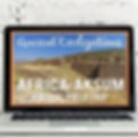6 Exciting Virtual Field Trips to Africa
- Michelle McDonald
- Feb 15, 2021
- 4 min read
Updated: Apr 5, 2022

Do your students recognize that Africa is a continent and not a country? I find that even middle school students still need a little reminder. If you are looking for a way to help your students better grasp and identify the location of places and regions of Africa as well as understand its physical and cultural characteristics, virtual field trips are an exciting and meaningful interactive learning option.
Technology today is pretty amazing. We can send our students on a virtual tour of the world and never leave the classroom--or our homes. A virtual field trip may seem a bit daunting, but I find that keeping virtual field trips straight-forward with plenty of structure work well. Built in clickable links, instructions, and informational text are all found in one place. Simple is key, while still offering students an engaging tour. Virtual field trips that are done well are more than just a web cam or a fun video. They designed in a meaningful way, with questions that spark curiosity and get our students to think critically. It can be easy to ask our students to summarize the text or look for the main idea, but these are reading questions, not historical thinking questions. Instead for example, I have students think about how the information presented challenges or supports their prior knowledge. Students are asked to think critically and make observations throughout the trip. With plenty of visuals, audio-visual, and time for Google Earth™ investigation, these trips are a well-rounded learning option.
Virtual field trips can be conducted teacher-led or shared with students through Google Classroom (as well as other LMS platforms) as an independent assignment. Everything is set up and ready to go. These trips are also a great option to set up as sub plans, because they are low prep and directions are included within the activity.
I want to share with you six virtual field trips that can be used with an ancient history study of Africa, or used to better understand the geography and history of the continent from multiple perspectives. All of these trips include Google Earth™ 360-degree exploration.
If you are teaching ancient history, this virtual field trip is a great option. In this virtual field trip, students learn about and explore 5 geographical locations. This trip includes: the Sahara, Niger River, Gulf of Guinea, Djenne-Djenno, and Timbuktu. This trip includes Google Earth™ exploration, video links, informational text and drag and drop map skills.
This virtual field trip is a great way for students to experience history. Take your students to Ethiopia to learn about the ancient African Kingdom of Aksum. This trip covers King Ezana's Obelisk, The Great Stelae, Church of St. Mary of Zion, the Ark of the Covenant, and Dungur Palace (Palace of the Queen of Sheba). This virtual field trip includes video content, informational text, and Google Earth™ exploration.
You can't forget about the Sahara and the Sahel. Using a combination of Google Earth™ 360-degree views, informational text, video, and visuals, your students will learn about the history, geography, and significance of the Sahara and Sahel.
This trip covers the geographic locations of the Sahara and the Sahel, physical features, climate, the significance of the Atlas Mountains, a look at Sub-Saharan trade, and the Sahara as a place of refuge. This trip also discusses desertification, climate change, and much more.
In this virtual field trip, your students will discover the features and significance of the African Savanna from multiple perspectives. This trip covers the geographic location the African Savanna, plants, the big five, the great migration, Serengeti National Park, and Kruger National Park. This trip also discusses some of the threats to the savanna and conservation efforts.
Again, all of this is set up and ready to go with Google Earth™ 360-degree views, video links, informational text, and response questions throughout.
Take your students on a virtual tour of the highest peak in Africa. In this activity, your students will get an up-close view of the summit and learn about the history and significance of this mountain from multiple perspectives.
This trip focuses on the geographic location and physical and geological features of Mt. Kilimanjaro. Your students will visit Kibo and Uhuru Peak, and Kilimanjaro National Park. As well, your students will learn about early inhabitants, the first ascent, and mountaineering today. This trip also covers the five ecological zones and impacts of climate change.
This virtual tour is all set up and ready to go! Take your students to the Kalahari Desert where they will learn about this geographic location from various perspectives. This trip covers the geographic location and key features of the Kalahari desert such as climate, soil & salt pans, vegetation as well as animals and birds. This trip also looks at the people of the region as well as threats to the Kalahari Desert.
Want to learn more about virtual field trips? Maybe not sure if they will be a good fit, or maybe you have some tech questions? Check out this blog post where I cover some of my commonly asked questions about virtual field trips.
Bring history and geography to life with virtual field trips!
The six Africa Virtual Field Trips can be found here:









